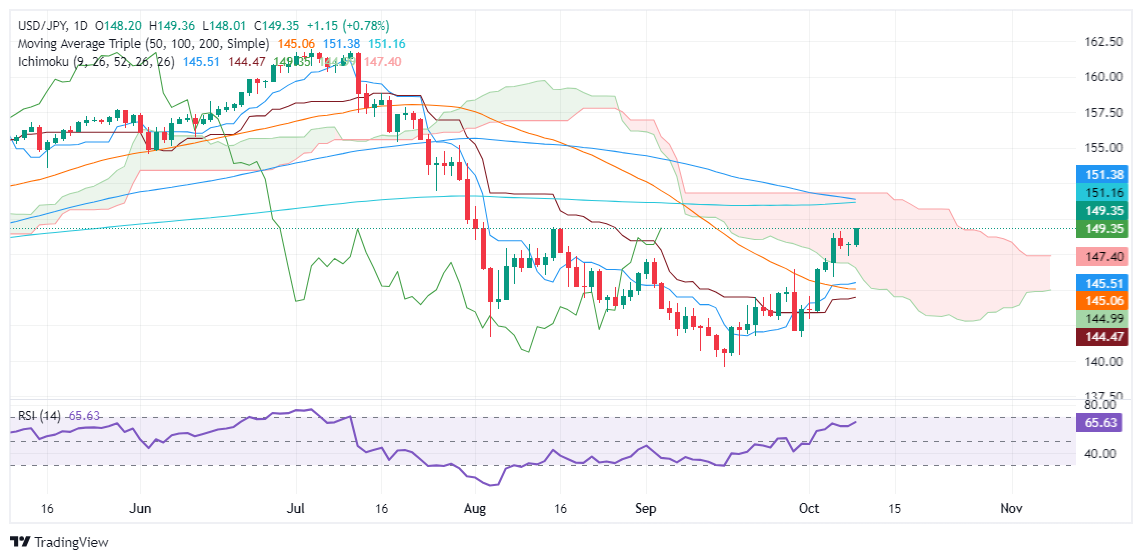USD/JPY Price Forecast: Surges above 149.00 sponsored by elevates US yields
|
- USD/JPY breaks key resistance, trading at 149.31, as high US yields and dovish PM comments support the pair.
- The Relative Strength Index (RSI) suggests room for further upside, with the August 15 high of 149.39 and 150.00 as the next targets.
- Key support lies at 147.35, with sellers aiming to push the pair below the Ichimoku Cloud at 146.40-60 and the Tenkan-Sen at 145.50.
The USD/JPY rallied and pushed above 149.00 for the first time since mid-August, sponsored by the jump in US Treasury yields due to their close positive correlation with the pair. This and dovish comments from incoming PM Ishiba sponsored a leg-up in the pair, which trades at 149.31.
USD/JPY Price Forecast: Technical outlook
The USD/JPY is neutral to upward biased after clearing key resistance levels like the 50-day moving average (DMA) and entering the Ichimoku Cloud (Kumo).
Momentum hints that buyers remain in charge via the Relative Strength Index (RSI). It should be said that the RSI is still far from being overbought, an indication that the pair could extend its gains.
If USD/JPY extends its gains above the August 15 high of 149.39, the 150.00 figure will be exposed. On further strength, the pair could challenge the 200-DMA at 151.39.
On the other hand, sellers will need to drive the USD/JPY below the latest cycle low according to the daily chart, being the October 8 low of 147.35. Once surpassed, the pair could challenge the bottom of the Kumo at 146.40-60, ahead of the Tenkan-Sen at 145.50.
USD/JPY Price Action – Daily Chart
Japanese Yen FAQs
The Japanese Yen (JPY) is one of the world’s most traded currencies. Its value is broadly determined by the performance of the Japanese economy, but more specifically by the Bank of Japan’s policy, the differential between Japanese and US bond yields, or risk sentiment among traders, among other factors.
One of the Bank of Japan’s mandates is currency control, so its moves are key for the Yen. The BoJ has directly intervened in currency markets sometimes, generally to lower the value of the Yen, although it refrains from doing it often due to political concerns of its main trading partners. The BoJ ultra-loose monetary policy between 2013 and 2024 caused the Yen to depreciate against its main currency peers due to an increasing policy divergence between the Bank of Japan and other main central banks. More recently, the gradually unwinding of this ultra-loose policy has given some support to the Yen.
Over the last decade, the BoJ’s stance of sticking to ultra-loose monetary policy has led to a widening policy divergence with other central banks, particularly with the US Federal Reserve. This supported a widening of the differential between the 10-year US and Japanese bonds, which favored the US Dollar against the Japanese Yen. The BoJ decision in 2024 to gradually abandon the ultra-loose policy, coupled with interest-rate cuts in other major central banks, is narrowing this differential.
The Japanese Yen is often seen as a safe-haven investment. This means that in times of market stress, investors are more likely to put their money in the Japanese currency due to its supposed reliability and stability. Turbulent times are likely to strengthen the Yen’s value against other currencies seen as more risky to invest in.
Information on these pages contains forward-looking statements that involve risks and uncertainties. Markets and instruments profiled on this page are for informational purposes only and should not in any way come across as a recommendation to buy or sell in these assets. You should do your own thorough research before making any investment decisions. FXStreet does not in any way guarantee that this information is free from mistakes, errors, or material misstatements. It also does not guarantee that this information is of a timely nature. Investing in Open Markets involves a great deal of risk, including the loss of all or a portion of your investment, as well as emotional distress. All risks, losses and costs associated with investing, including total loss of principal, are your responsibility. The views and opinions expressed in this article are those of the authors and do not necessarily reflect the official policy or position of FXStreet nor its advertisers.
